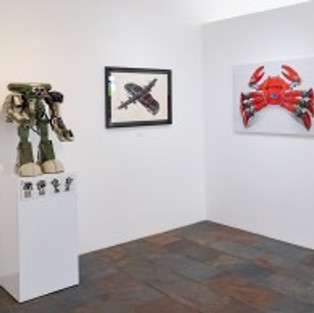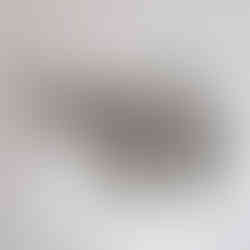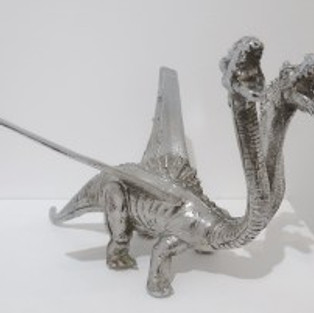of Machines and Men at saltfineart
- artandcakela
- Jan 21, 2019
- 3 min read
Updated: Jan 28

of Machines and Men at saltfineart, installation view. Photo courtesy of the gallery.
of Machines and Men at saltfineart
Through January 31, 2019
By Liz Goldner
The five artists featured in this exhibition are creative heirs of Leonardo Da Vinci, the 15th century artist/inventor who designed a variety of forward-looking inventions.
While history has scrutinized Da Vinci’s influences over the centuries, the artists in this show draw on childhood and nostalgic influences, along with observations of the world around them, in the creation of their work. The result is a playful, impactful exhibition, featuring a variety of imaginary mechanical devices, along with poignant scenic photographs.
Laguna Beach’s Gerard Basil mines his childhood memories to create intricately sculpted bronze objects. His Provenance is a finely wrought old-fashioned tricycle, while Flyer is a replica of his childhood wagon. Paper Airplanes are bronze versions of the airplanes we played with before video games took over. And Fact or Fiction, the artist’s most abstract sculpture, has the shape of an old fashioned typewriter, with the keys and carriage smoothed out.
Cristian Castro, who was captivated by the inner workings of machines from an early age, creates fanciful, colorful robots, constructed from discarded parts of airplanes, cars, toasters, vacuum cleaners and other objects. His pieces in the show include Egg-771, a large bright red crab-like assemblage piece that employs the back of a Volkswagen bus as the piece’s center. His Kinoto, an orange and gray flying robot with a reptilian face, wears a gleeful expression. While Hunter, incorporating an old camera for its face, is a more traditional looking robot. Other robots in this series include the intimidating Black Soldier and Search Light with an actual searchlight for a face.
Cuban artist Esterio Segura is known for his drawings, paintings and sculptures featuring Pinocchio as a metaphor for the denial of the starkness of life in his country. Yet his pieces in this exhibition include art pieces with wings, expressing his belief that many Cubans would leave their country if they could. His Hibrido de Chrysler, an ink on paper drawing of a 1950s Chrysler, with wings affixed to its roof, symbolically carries people away from the country that they love. “Goodbye My Love,” a bright red fiberglass sculpture, features a heart with wings, symbolizing the deeply felt desire by many Cubans to fly away. And with the same theme, the artist’s cast bronze sculptures Hibrido de Elefante and Hibrido de Dragon are depictions of animals with wings.
Jorge Lopez Pardo, also living in Cuba, creates graphite on canvas drawings. These artworks, with several featuring circular white shapes on luminous black backgrounds, are both abstract in execution and ethereal in their aspects. With titles as Entre Dos, Intertwined, Rutina Entre Dos and Principio Y Fin, they conceptually illustrate airplanes, while conveying the collective Cuban yearning for freedom.
Cuban artist William Perez’s Einstein, a round Plexiglas plate with an illustration of Einstein’s face, curiously includes large orange plastic knobs, turning the 20th century genius into a mechanical object. The artist’s My Garden Shovel is a contrasting elegant sculpture of a shovel, also made of Plexiglas.
Departing from the machine-oriented pieces are photos by Baldemar Fierro, an artist whose camera and image editing software are mechanical tools that capture expansive settings. His Ipanema Beach, a 72-inch wide color photo, shows the breadth and depth of this legendary spot, replete with wall-to-wall sunbathers, beach and ocean with churning waves. Hwy 89, Arizona captures sand dunes that are so majestic, they resemble ocean waves. Yet in his Balos Beach, Crete, he has manipulated the sand and bluffs to appear like strokes in an abstract painting.
of Machines and Men, saltfineart
346 North Coast Highway, Laguna Beach, CA 92651
#losangeles #california #LizGoldner #art #painting #LagunaBeachArt #LagunaBeach #losangelesart #contemporaryart #southerncalifornia #abstract #collage #EsterioSegura #LeonardoDaVinci #artgallery #gallery #WilliamPerez #artandcake #artopening #assemblage #artexhibition #installation #ArtandCakeLA #fineart #GerardBasil #artists #artist #soloshow #mixedmedia #arts #environment #CristianCastro #artreview #sculpture #artmagazine #saltfineart #ArtandCulture #exhibition #JorgeLopezPardo #BaldemarFierro #exhibit #dtla










































